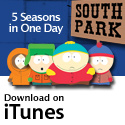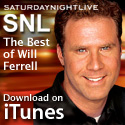The Best of "The Colbert Report" DVD Review
Earlier this decade, there was a recurring segment on Comedy Central's "The Daily Show" called Even Stevphen. It would pit two of the fake news show's correspondents, who had variations on the same first name, against each other in juvenile debates on a variety of topics. One reporter was Steve Carell, who today is the star of NBC's "The Office" and a number of high-profile movies. It wasn't quite the leap that Carell made; Colbert essentially maintains the persona he developed on the Jon Stewart-hosted program, which the "Report" follows Monday-Thursday nights at 11:30 PM Eastern/Pacific. The game is still political humor and while "Colbert Report" has a style distinctly its own, it's easy to see a relationship between this show and the one it spun off of.
Still, "The Colbert Report" and its absurd host have entered into the national consciousness more quickly and extensively than Stewart and "The Daily Show" have. At the moment, Colbert's recently-published "autobiography" I Am America (And So Can You!) ranks among the best-selling books on Amazon.com. Colbert has also been making news since earlier this month when he announced an apparently legitimate bid for President of the United States. This move has found him filing in South Carolina as both a Republican and a Democrat as a "favorite son" candidate.
Colbert is no overnight sensation. In the two years of hosting his own program, he has interviewed countless political leaders, made contributions to the English language, performed for President Bush at the White House Correspondents' Association Dinner, and been celebrated by Time, People, and even Ben & Jerry's. Whereas on "The Daily Show", Jon Stewart injects genuine liberal leanings into biased coverage and passive-aggressive interviews of Republican figures, Colbert's show has a more overtly partisan approach and yet a less polarizing appeal. His character's unwavering patriotism, relentless conservatism, and immobility from irrational stances are all in good fun. He's modeled after Bill O'Reilly from Fox News' "The O'Reilly Factor", only he's playing for laughs (while usually maintaining a straight face). Conservatives can appreciate Colbert's principles, liberals can see them as pure parody, and, as on "The Daily Show", everyone is able to find and appreciate the humor in politics and news stories. Even those for whom the word "politics" induces a shudder can find much silliness to enjoy in "The Colbert Report", such as when its host interviews celebrities or declares war on bears, Canada, and robots.
Reaching stores on November 6, Comedy Central and Paramount's The Best of The Colbert Report marks the series' first appearance on DVD. Rather than serving up complete episodes, Best of compiles a wide variety of standout segments from the first 300 or so installments of "The Colbert Report." Colbert's tongue-in-cheek punditry is enjoyed in a number of settings. There are his hilariously pointed interviews with congresspeople for the 434-part "Better Know a District" series on U.S. congressional districts. There is his near-daily sounding board segment in which he introduces "The Wørd" and breaks it down while on-screen text elaborates, disputes, or punctuates his commentary. Among the two of these included is the beginning of his first episode, in which he creates the tone-setting word "truthiness." As part of the not so humble recurring segment "Who's Honoring Me Now?", Colbert revisits the series' start after "truthiness" is voted Merriam-Webster's Word of the Year.
Quite a bit of the material selected for this DVD stands out as special and out of the ordinary. A prime example of this is the Green Screen Challenge, in which footage of Colbert swinging a lightsaber against a neon background spawned a number of interesting video submissions, including a highly deserving winner's mock video game. The winner's ceremony provides an appearance from none other than Star Wars creator George Lucas, who even has his own state-of-the-art stab.
Guest stars are a prominent theme to the collection, particularly in the final two hours. The final episode of 2006 seems to have been included in full. This special show gives us "Stephen Colbert's Rock and Awe: Countdown to Guitarmageddon", in which Colbert agrees to a shred-off with the guitarist from the Decemberists in retaliation for the band's copying of his Green Screen Challenge idea for a music video project. Elsewhere, appearing separately for an interview and a song are Barry Manilow (fresh off his Emmy defeat of Colbert) and Willie Nelson (a fellow Ben & Jerry flavor subject). Actress/activist Jane Fonda appears twice, first with Gloria Steinem in a near-surreal segment on women in which Colbert dishes out cooking orders for the two feminists. The second time, she's on her own and on Colbert's lap, with the host using her reason for being there (promoting Georgia Rule) as a safe subject to move away from their ridiculous proximity. The winter 2007 visit by Colbert's "Papa Bear" Bill O'Reilly is anticipated, showcased, and the body language in Colbert's crossover to "O'Reilly Factor" later dissected. Less spirited is Sean Penn's spring '07 appearance. Shortly after using unusual imagery to bash the President, the actor competes with Colbert in a Meta-Free-Phor-All game show hosted by former Poet Laureate Robert Pinsky.
While providing some clear highlights in the show's young first two years, the DVD gladly isn't all about celebrity guests and unique segments. A fair amount of it is merely Colbert being Colbert, encouraging Wikipedia users to take truth into their own hands, tracking the movement of his bald eagle "son" Stephen Jr., informing viewers of America's biggest current threats in the oft-updated "Threat Down", and betting against the mayor of Oshawa on an Ontario Hockey League game. This type of fare is the bulk of a typical episode and despite being less glamorous than ambitious charades, the man-at-the-desk stuff is some of the show's funniest.
VIDEO and AUDIO
As on TV, "The Colbert Report" is presented in 1.33:1 fullscreen. It's perfectly clean, crisp, and detailed here. In other words, it's as broadcast, only with a higher resolution and without commercial breaks and a Comedy Central network bug (which shows up only in one short "Indecision 2006: Midterm Midtacular" segment). BONUS FEATURES, MENUS, PACKAGING and DESIGN
There are no bonus features included, but for several reasons, this is one of the most forgivable instances of an extras-less DVD. For one thing, there's three hours of content, so we're already pretty much filled to capacity. For another, the studio could have been cheesy and designated some of the segments as bonus features with no effect on the disc's composition. (In fact, one brief part of the featured presentation is called "a deleted scene" without special distinction.) In addition, as a compilation of a program intended chiefly for TV, it's not like this DVD was necessarily long in planning and posed opportunities for bonus footage.
I can only imagine how little free time Colbert has, as someone who produces four new current half-hour episodes a week. A book and presidential campaign are doubtlessly a better use of it than filming DVD bonuses, which might very well have felt like a sales gimmick as content not shown on TV sometimes does. In the end, while a behind-the-scenes look at "Colbert Report" production would be interesting (and slightly illusion-shattering), I still think more people would prefer to watch segments from the show than that, which justifies the disc space going to it.
Appropriately enough, the DVD's main menu opens much like an episode of the show does. The three mildly-animated, patriotic pages to it offer access to 19 sections while playing the instrumental theme music. The DVD is actually divided into 41 chapters, so some of the segments that the menu takes you to are actually multiple chapters. Only one, "Better Know a District", actually supplies a submenu. After the section is complete, you're returned to the menu.
The disc opens with previews for Christmas Time in South Park, "The Sarah Silverman Program": Season One, and Demetri Martin. Person.. These are also accessible from the first page of the menu.
Inside the case, one finds a 6-page booklet which folds open to showcase the several dozen DVDs available for Comedy Central series and specials. On the back, there is a quote match activity and a code to save 15% on stand-up comedy DVDs at the channel's online shop.
CLOSING THOUGHTS
It's tricky figuring how best to handle the DVD release of a show that has generated over 300 episodes in two years, especially when the show deals largely with politics and current event issues. Nevertheless, The Best of The Colbert Report gets it right, with three hours of varied, consistently entertaining programming that lends itself to multiple viewings and whim-based sampling. Delivering lots of content for a very reasonable price (especially considering the $1.99 iTunes charges for less uniformly excellent full episodes), the disc earns a strong recommendation for fans of Colbert and those lacking access who are interested in seeing the show.
|
Related Reviews:
Evan Almighty • Blades of Glory • Unaccompanied Minors • Hannah Montana: Life's What You Make It
Knocked Up: Extended & Unrated - 2-Disc Collector's Edition • Family Ties: The Second Season
Homie Spumoni • Kickin' It Old Skool • Back to School: Extra-Curricular Edition
Brothers & Sisters: The Complete First Season • Kyle XY: The Complete First Season
America's Heart & Soul • Walt Disney Treasures: Walt Disney on the Front Lines
DVDizzy.com | New and Upcoming DVD Schedule | DVD Reviews | Upcoming DVD Cover Art | Search This Site















